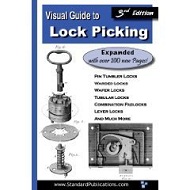Lock Picking Techniques
Techniques to pick different types of locks
Pin tumbler locks
Pin tumbler lock: A tension wrench (or torque wrench) is used to apply a torque to the cylinder, while a lock pick (or picklock) is used to push individual pins up until that they are flush with the shear line. As each pin is manipulated to its correct height, the cylinder will turn fractionally causing another pin to bind. The pins will not bind simultaneously because they will not be aligned perfectly with the axis of the cylinder. Once all of the pins are flush with the shear line, the tension wrench can be turned fully to open the lock. Raking or scrubbing a pin tumbler lock is usually done before individual pins are pushed up. While applying torque with the tension wrench, a lock pick with a wide tip is placed at the back of the lock and quickly slid outwards with upward pressure so all the pins are pushed up. Raking may allow some of the pins to be flush with the shear line and can make the job easier. Some pin tumbler locks have special pins, with serrations, mushroom heads, or spool shapes, that make lock picking more difficult by causing the pins to bind in locations other than their correct ones. Another technique, often the fastest, uses a vibration pick or gun, which sharply strikes all the bottom pins simultaneously while light torque is applied; like a cue ball, the energy is transmitted through to the top pins, which fly to the top of their well. This momentarily creates a large space between the two pins. To defend against these attacks, high-security locks use a sidebar, which engages from another axis and also prevents the lock from turning. Medeco does this by requiring the pins to be rotated to a correct position, as well as moved to their correct height. Other brands put the sidebar cuts in the side of the key. Pin tumbler locks are sometimes arranged in groups, where each lock in the group can be opened by either a master key, which will open any lock in the group, or a specific change key, which will open only that one lock. This is done by using pins with more than two parts, so that it will shear at more than one position. In poorly supervised areas, those who have access to a door which is unlocked or for which they have a legitimate key can remove the lock from the door and disassemble it to determine the master keying pattern.
Picking Tubular Locks
Now lets take a look at picking tubular locks. Tubular key locks are most often found on vending machines such as washing machines, candy and soft drink vending machines and the like. It was named "tubular" because of it's key being a tube and the lock's tumblers cuts cut around it (arranged in a circle.) A tubular lock pick is used to keep the pins from moving once they have been picked until all have been picked. If you plan do do a lot of tubular lock work you should invest in a tubular pick tool. A tubular lock key has a tubular blade. The key cuts are made into the end of the blade, around the circumference. Check out our page on tubular locks and picks for more detailed information and tips on how to use a tubular pick properly.
How to Pick a Combination Lock
Cheap combination padlocks can be opened using a thin metal piece slid between the body and shackle. These thin pieces of metal are commonly known as padlock shims. Padlock shims are made of very thin spring steel, and they come in 3 or 4 sizes to fit the contour of the hasp of the lock. Just push one down between the hasp and the body of the lock and twist to disengage the the locking mechanism and Voila! It's that easy to open an inexpensive padlock.
Padlock shims are inexpensive and commonly used to open inexpensive (simple) padlocks. They can be used only 3 or 4 times and then will need to be replaced.&npsp; This article discusses how to properly use padlock shims.
There's a pretty decent book on the market today that takes the guesswork out of opening combination padlocks. Opening Combination Padlocks by Carl Black is a good resource if you find yourself in a jam. It is incredibly easy to forget the combination to padlocks on your own tool shed, gym locker or anyplace else these common locks are found. Learning how to pick a combination lock isn't as difficult as you may think. More expensive padlocks require the lock-picker to find the combination to the lock. The exact technique to do can differ and some manufacturers, such as Master Lock, make this process very time-consuming on their latest models.


